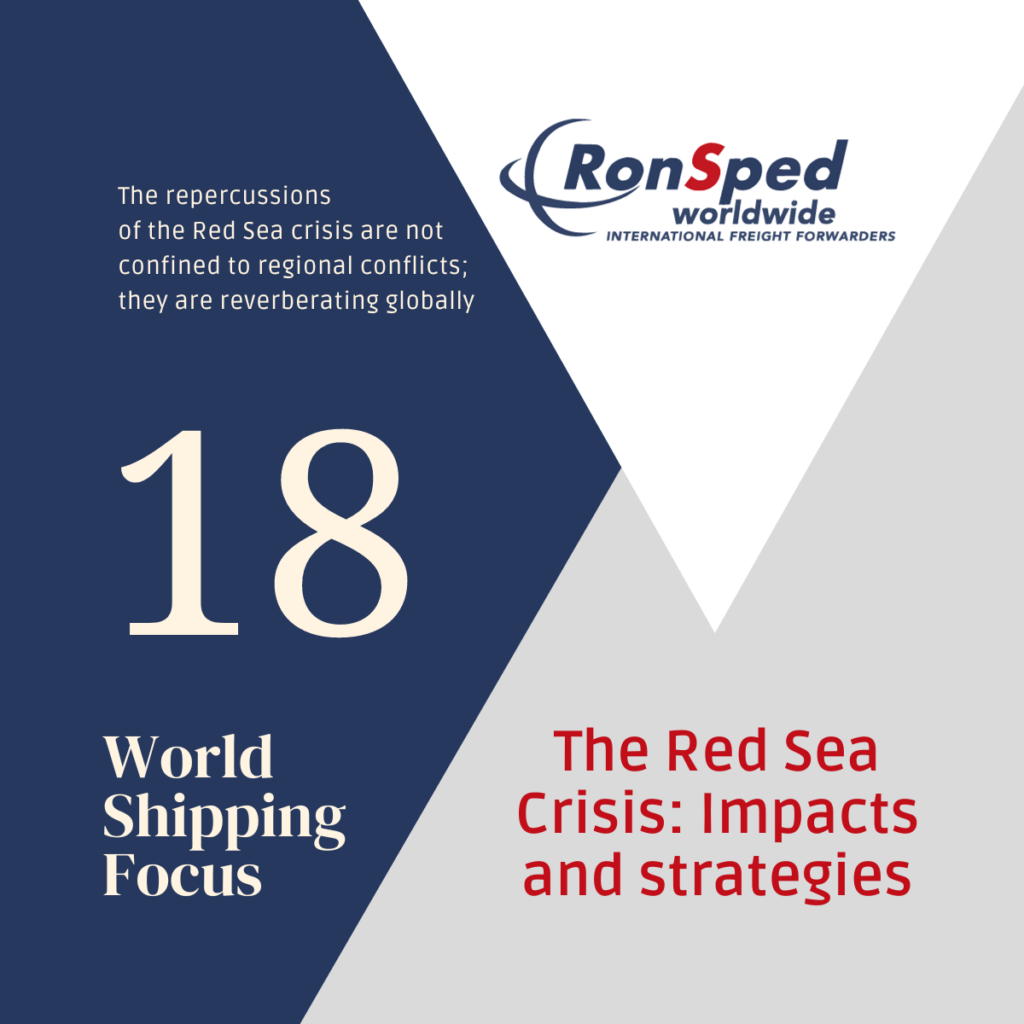
The Impact of Transport Costs on Prices and Inflation
10 Ottobre 2023X2 Container Network
23 Febbraio 2024The disruption caused by escalating conflicts in the Red Sea has sent shockwaves through global trade, forcing major shipping companies to reroute vessels around the southern tip of Africa. This crisis, triggered by attacks from Houthi militants in Yemen, is beginning to take its toll on the world economy.
What’s happening
The Red Sea route, a crucial pathway through the Suez Canal, accounts for approximately 12% of global maritime traffic. Recent armed conflicts in the region have led to a significant drop in the number of containers traveling daily through the Red Sea, falling by 60% from 500,000 in November to 200,000 in the following month according to the report by the German economic institute.
The Houthi insurgents, operating from Yemen, claim retaliation for Israel’s military actions against Hamas in Gaza. Despite increased maritime security efforts by the US military and its allies, attacks persist and tensions heightened as the US and UK conducted air and missile strikes in Houthi-controlled areas of Yemen to thwart Red Sea ship attacks. Over 60 targets in 16 Iranian-backed Houthi locations were hit, responding to a drone and missile attack on American and British warships. This military action led to a 2% increase in oil prices, reaching nearly $79 per barrel, raising concerns about broader Middle East conflicts impacting regional oil supplies.
Vincent Clerc, Maersk’s chief executive, said on Thursday the Red Sea disruption could last for months. He said the attacks by Houthi militants were “brutal and dramatic” and could lead to further inflation across the global economy.
Economic Ramifications
The repercussions of the Red Sea crisis are not confined to regional conflicts; they are reverberating globally. The shipping industry is grappling with the challenges posed. Companies such as Ocean Network Express, Orient Overseas Container Line, Wallenius Wilhelmsen, and Yang Ming are either temporarily halting Red Sea voyages or redirecting their ships. The industry giant Maersk, responsible for moving 20% of global trade each year, has suspended Red Sea operations indefinitely due to attacks on their vessels. The resultant rerouting around the Cape of Good Hope adds 1-2 weeks to travel durations, disrupting supply chains and contributing to rising freight rates.
Impact of the Red Sea crisis on Global Trade and Economies
According to reports by the German economic institute and Goldman Sachs, around 30% of global container trade has been affected, leading to rising inflation, delayed goods, and increased oil prices. With 70-80% of vessels being rerouted as of December 2023 and approximately 30% of global container trade affected, according to Goldman Sachs, the crisis is creating bottlenecks that could extend into the Chinese New Year and beyond.
The closure of one of the world’s main trade routes has led to significant diversions, with carriers avoiding the Red Sea to the tune of over $200 billion in trade. This has triggered warnings of inflation and delayed goods, adding pressure to an already complex global economic landscape.
Oil prices are experiencing an uptick, with both Brent and US crude registering approximately a 3% increase on Friday. These price hikes are driven by concerns over a potential broader regional conflict that could disrupt oil supplies. The anxiety in energy markets was further heightened following Iran’s seizure of a tanker in the Gulf of Oman on Thursday.

Short term impacts of the Red Sea crisis
An instanti impact sees involved Tesla (TSLA) that is temporarily halting the majority of its production at its electric car factory in Germany due to supply disruptions caused by the recent attacks. Retailers are cautioning about potential delays in shipments, and the expenses associated with maritime transportation of goods are on the rise.
According toBalika Sonthalia, a senior partner and supply chain expert at global consultancy Kearney, the initial quarter of the year typically sees a lighter import volume for retailers. Most retailers are grappling with unsold inventory from the holiday season so the expected rise in shipping costs is likely to impact imported goods prices over time, with a portion of the pressure translating into lower profit margins rather than immediate increases in prices.
According to JPMorgan, the New York Federal Reserve’s Global Supply Chain Pressure Index did not exhibit a significant increase in December. However, the repercussions of shipping disruptions might manifest with a delay if they persist for more than a month, as suggested by the investment bank.
Ongoing Challenges and Future Outlook
As the Red Sea crisis unfolds, challenges persist, including low water levels in the Panama Canal, potential labor unrest, extreme weather events, and shifting geopolitical tensions. Mike DeAngelis, Head of International Solutions at FourKites, emphasizes the need for vigilance and proactive planning to navigate the unpredictable dynamics inherent in the shipping industry.
Rising Inflation Concerns
The threat of violence in the Red Sea region has contributed to longer shipping times, higher freight costs, and a potential return of inflationary pressures. Larry Lindsey, CEO of the Lindsey Group, warns that central banks may face challenges in combating inflation if the Red Sea crisis continues.
Long term impacts of the Red Sea crisis
The disruption in key shipping routes, combined with existing challenges, has led to increased ocean freight rates. Businesses are already experiencing delays, higher shipping costs, and potential shortages of goods. The impact on the supply chain may extend into the first quarter, affecting consumer prices.
Beyond the Red Sea crisis: Strategies for Mitigation
The Red Sea crisis is causing a seismic shift in global trade, with far-reaching consequences for shipping routes, economies, and consumer goods. The ongoing challenges underscore the need for strategic planning and collaboration within the shipping industry to navigate these turbulent waters.
Industry experts suggest various measures to mitigate the impact. Long-term contract caution, transparency with customers, exploration of multimodal transportation options, and collaboration with logistics partners are recommended to maintain schedule reliability, supply chains, and customer demands.
We will keep monitoring the evolutions and analyzing the possible solutions to offer our clients the best service possible.
Read the other World Shipping Focus News:
Post 2M. perspectives in container shipping
India as a global hub for logistics and manufacturing
The 2035 ban to endothermic engines in Europe and how it affects Italy’s economy and export
The value of Cosmetic industry in Italy and the export forecast for 2023
The New Wave of Container Ships: Bigger and More Sustainable?
The rise and fall of the new Silk Road
Revolutionizing Storage and Logistics: VLMs and VSWs
The Evolution and Future of Space Logistics: Unlocking the Potential of Outer Space
The 13 Commercial Water Canals: Opportunities and Threats
Decarbonizing Transports: A Global Imperative
Understanding the Differences Between Customs Warehouse and Tax Warehouse
The Impact of Transport Costs on Prices and Inflation
Sources:
https://edition.cnn.com/2024/01/10/economy/red-sea-attacks-economic-impact/index.html
https://www.cnbc.com/2024/01/03/red-sea-crisis-shipping-costs-delays-inflation.html



